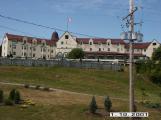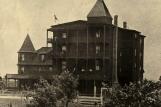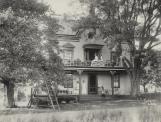

Admiral Digby Museum
Digby, Nova Scotia
1
HOTELS AND LODGESThe arrival of the railway and improved steamship services, in the late 1800's, encouraged an increase in the number of hotels and lodges. During the early 1900's Digby and Digby County was advertised as the "Summer Play Place of Nova Scotia", allowing for the expansion of existing hotels and lodges as well as the construction of new ones. During the summer months the population of the Digby area nearly doubled with the addition of tourists.
Today Bed and Breakfast businesses are scattered throughout the area as well as several hotels and motels. Tourism is still a major industry, but the days of the grand lodges have long passed.
3
This two-storey structure originally known as the Waverely [sic] House, was a tourist establishment owned by Miss Forsythe and Mrs. Joseph Merritt; it was destroyed in the fire of 1899.Later rebuilt, the Waverely [sic] became a well patronized commercial hotel, which besides offices and reception parlour had 35 well furnished guest chambers. The dinning room seated 45 persons, while the meals always embracing several courses, were promptly and daintily served.
Information taken from: Digby and Digby County N.S. - The Summer Playground of Nova Scotia, 1918.
5
Built circa 1864, it was originally known as the Raymond House, a summer hotel, owned by Stewart Raymond. On A. F. Church's map of 1864 (located at museum), it is shown as the Episcopal Rectory. Several names etched on the windows include that of Henry V. Almon, August 28th, 1860, who was a clergyman at Trinity Anglican Church.The main house and ell were built at different times.
A store was built by Stewart Raymond on the back lot on the corner of Queen and Warwick Streets in 1908 setting the foundation for a business block.
The 19th Century building was restored by the present owners and operated as Summer's Country Inn.
7
The Manhattan Hotel, built and operated by the Troupe family, began business on January 13th, 1900 and remained open until 1913. The hotel was torn down in 1945. Located across the street from the Annapolis Basin, it offered access to many water-related activities: boating, canoeing, racing. The pavillion and bandstand were nearby. Extra guests were accomodated at the annex (Salvia House/Bayview B&B) two buildings to the north. A small Loyalist building was incorporated into the hotel structure but was destroyed when the hotel was taken down. At present the 'Movie Gallery' is located on the same location.9
Originally built as a one-and-a-half story log house, the Salvia House was used as the home and office for the owners of the Manhattan Hotel.In 1910, an addition to the house was made with the results as it stands today. After this addition, the house was used as the annex to the Manhattan Hotel and has offered accomdation to tourists and travellers. Today it is still in operation as a Bed & Breakfast.
12
The Pines Resort was built in the style of a Norman Chateau. It perches majestically on the hilltop, 250 feet above the Annapolis Basin. Consisting of three stories and forty sleeping rooms, the first Pines Hotel was constructed in 1905 by Harry Churchill. In 1913 the Government took it over to use as WW1 officers' quarters, and i 1919 sold it to the Canadian Pacific Railway (CPR). They tore it down in 1928 to build the existing one (opened June 24, 1929) which currently has 83 rooms and suites and 30 cottages.14
Once known as the Myrtle House, a summer hotel, now an apartment building. The original building was more than twice its present size. It boasted a spectacular view from the fourth floor, as well as from the very large veranda. Stained glass diamond carvings were a feature of the building prior to the fire in 1979.18
On the south end of Digby the Lour Lodge, now known as the Marla apartments, could accommodate 150 guests at the main hotel, annex, and eight water-front cottages. Opened year round the lodge charged $2.00 - $5.00 per night, $10.00 for a week, during the off season and $12.00 for July and August. Three tennis courts and a large lawn space was at the disposal of guests.During the war years the lodge was known as the Navy Hostel.
20
Smith's Cove dates back to the 1750's. Eventually the property was owned by a Joseph Potter who was the first British subject to settle there in 1763. The grant was changed in 1783 to Joseph Smith and this is who the community was later named after. The community was known for farming, fishing, and trade but with the 20th century Smith's Cove developed a new industry in tourism. The town grew with many new Hotels and Inns. The first hotel was Presto and was opened in circa 1880 by Benjamin Hunt. It was also called the Imperial House at one time. In 1908 it was changed to the Wohneda Lodge and in April of 1929 the house burned to the ground.22
Harbour View, established some thirty-five years ago by the late William Cossaboom, has for years enjoyed the reputation of being one of the finest and best known resorts in the Maritime Provinces. Harbour View was known to many from all over the continent.A. D. Cossaboom succeeded his late father as proprietor of the hotel.
The Harbour View Hotel burned to the ground, September 1939!
Not to be mixed up with the Harbourview Inn which is still in operation today!
24
A store on the corner, owned by Mr. Edward Rice, was sold to Wilfred Chute. When remodelling was done and an addition built on, it was named the Grand Central Hotel. Sample rooms provided travelling salemen places to show their wares. Mrs. Chute's father, Captain Joseph Rawding, a former sea captain, made his home at the hotel for twelve years.At ten minutes to twelve, the lights dimmed a warning, as at midnight Derby Jack and later Levi Peck turned lights off at the Power House. In the winter they were turned on at 5:00am. It was necessary to use kerosene lamps at times.
Above information taken from Digby Courier - December 10, 1981
The Grand Hotel, located in Bear River, still stands today as a link to Bear River's booming past, more than a half a century ago. Travellers often filled the Grand's twenty bedrooms when the town buzzed with activities from the wharves. By 1923, the Grand Central Hotel was turned into three apartments, with several businesses operating on the ground floor. Today the Grand stands unoccupied and insignificant in today's quite little community.












